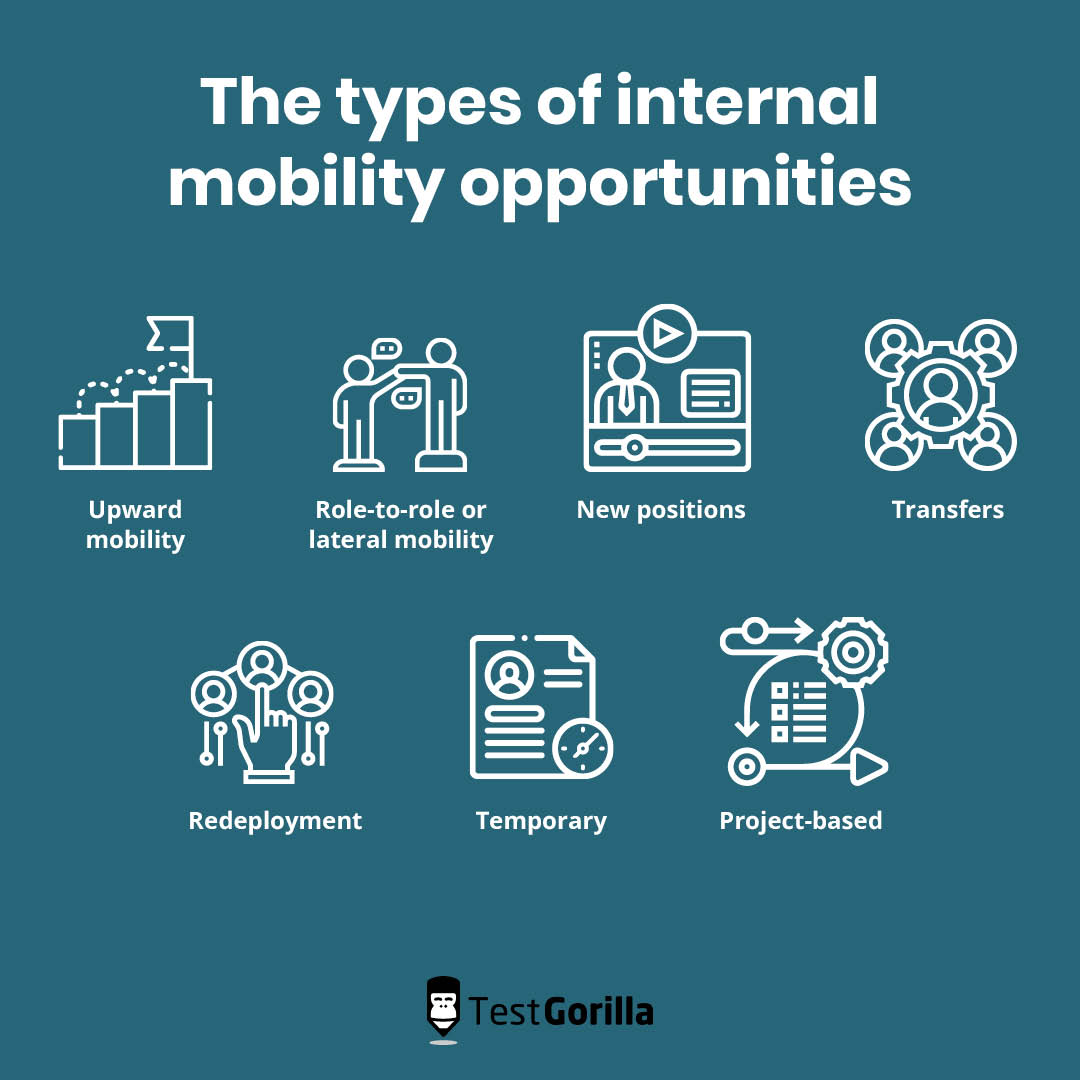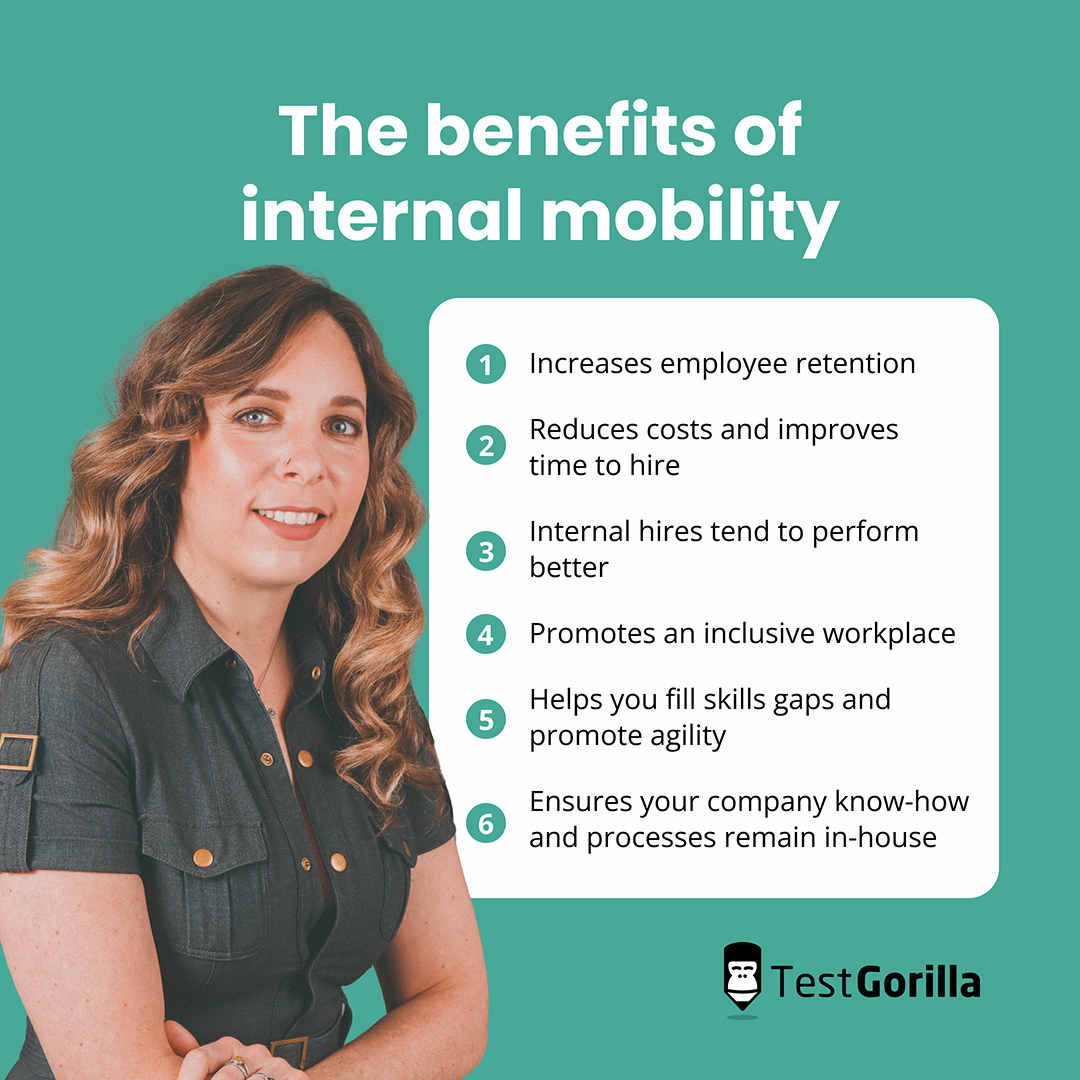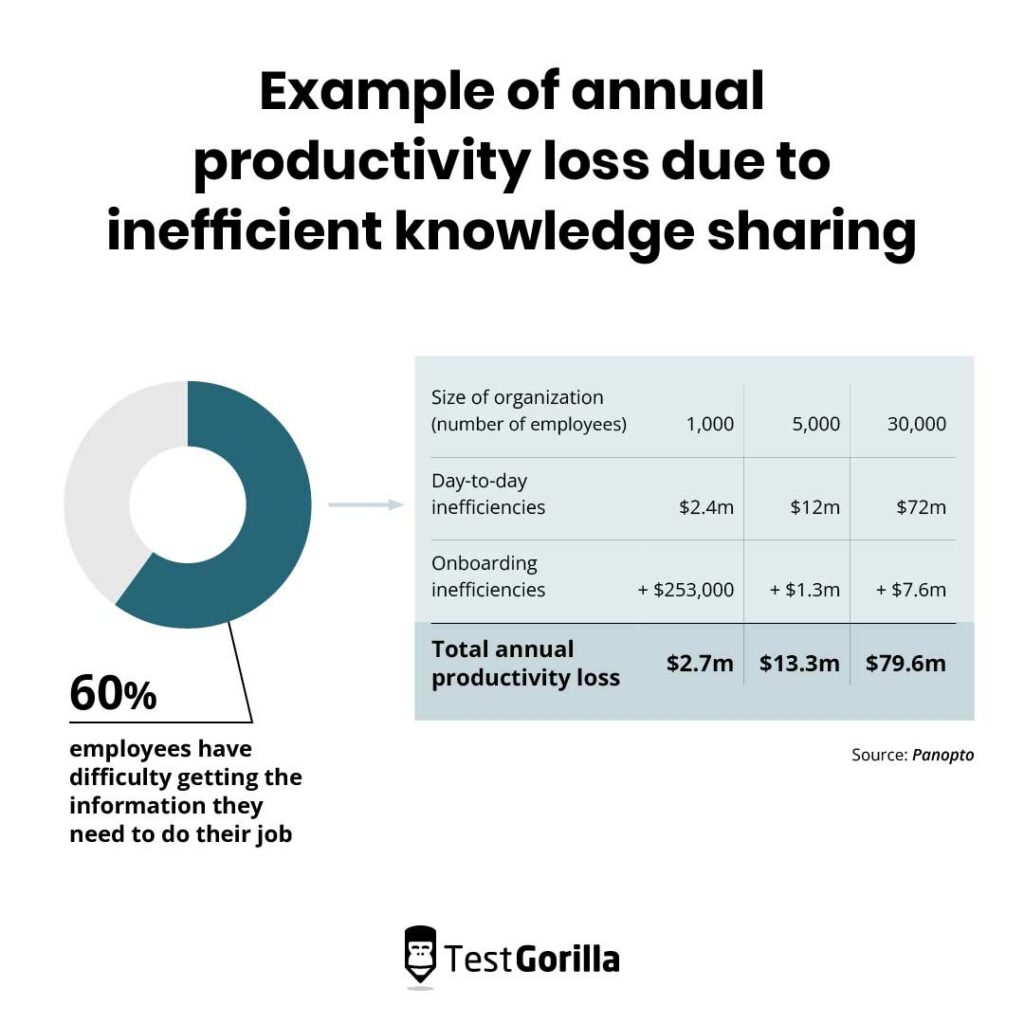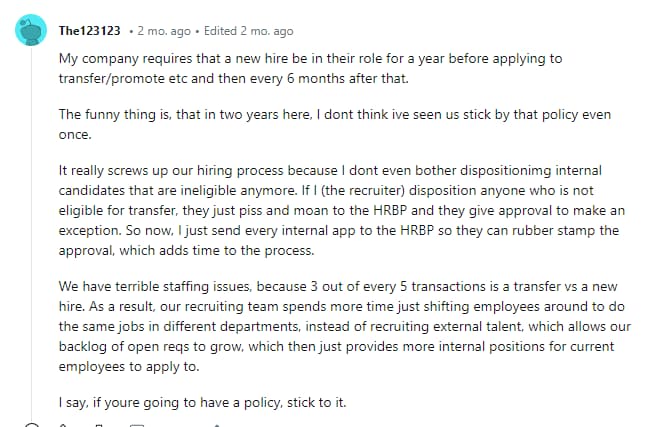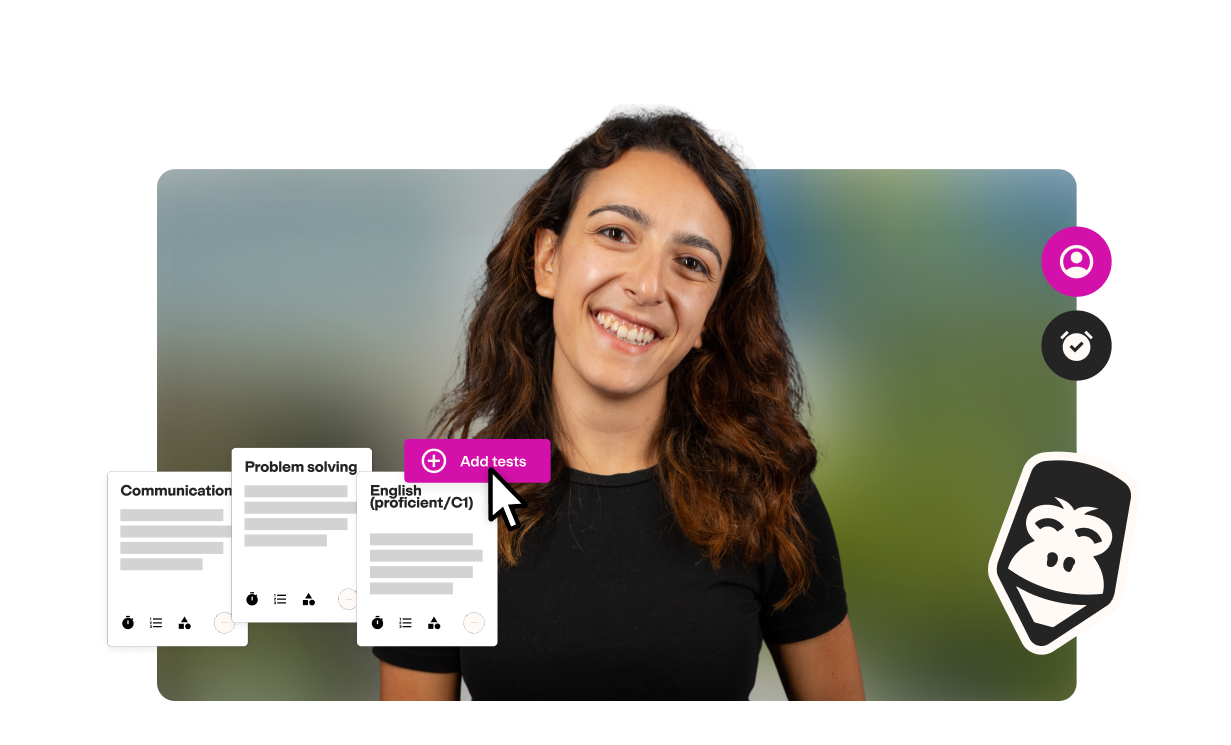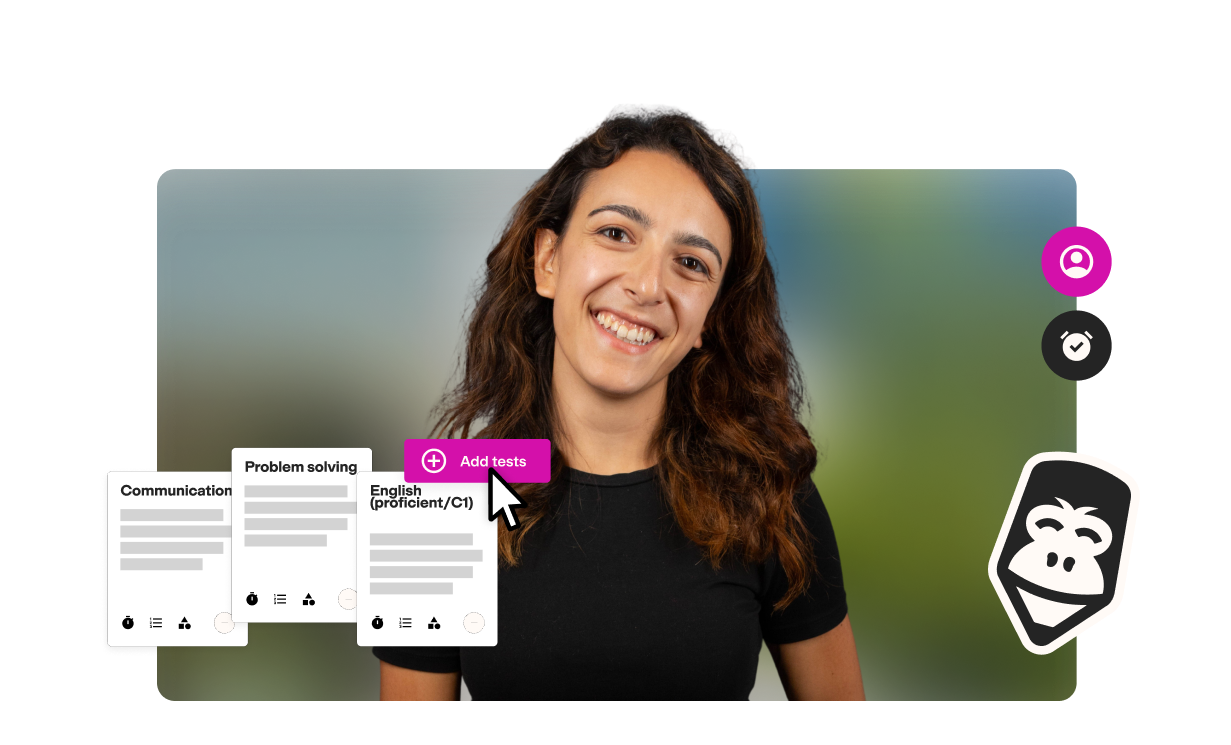In 2023, offering growth opportunities is no longer a nice perk for employees – it’s imperative for retaining your top talent.
Research from Gallup shows that around 48% of employees would switch to a new company if it offered more upskilling and career advancement opportunities.[1]
By overlooking these initiatives, you risk losing some of your best employees. Moreover, finding new talent with the right skills through external hiring can become an uphill battle for human resources teams as skills shortages spread across industries.
An internal mobility strategy solves both these problems at once.
Instead of relying on external talent, internal mobility focuses on filling open roles with the existing skills in your organization, cultivating a culture of learning and growth within your organization.
It empowers you to optimize your untapped potential and help your employees navigate their career trajectories within the company.
This article explores what internal mobility means, why it’s a top employee retention strategy, and how to use talent assessments to facilitate internal talent mobility and retain your best employees.
Table of contents
- What is internal mobility?
- Why is internal mobility important?
- The benefits of internal mobility
- 9 best practices for leveraging internal career mobility to retain your top performers
- 3 examples of companies succeeding with internal mobility as a talent retention strategy
- Retain your top talent with internal mobility
What is internal mobility?
Internal mobility is the vertical and lateral movement of employees within an organization. Promotions, switching roles, participating in mentorships or additional projects, and job shadowing are some examples of internal mobility seen in organizations.
In a company with a culture of internal mobility, you first consider your internal employees to fill vacancies before turning to external recruiting processes.
Focusing on internal mobility helps you stay on top of emerging employee retention trends while helping your employees reach their career goals.
Moreover, it empowers you to leverage the skills of existing employees in your organization to fill a position and address the skills gaps within your organization.
The 7 different types of internal mobility
Most forms of internal mobility fall into one of these seven categories:
1. Upward mobility: The most traditional form of internal mobility, where the employee moves up in terms of responsibility and compensation – for example, when a content editor gets a promotion to senior content editor.
2. Role-to-role or lateral mobility: This is when employees make a sideways or lateral move, usually within their own teams, with little or no change to their seniority or salary – for example, a C++ programmer moving into a Java programmer role.
3. New positions: Here, employees move into a newly created role that’s on the same level as their current one in terms of responsibility and salary.
4. Transfers: Employees keep the same role but move to a new location, whether temporarily or permanently.
5. Redeployment: Redeployment is when an employee begins a new career within your business, whether as part of a career pivot or restructuring. It may be a similar or different role from their previous one, and may be at the same or a different location.
6. Temporary: This kind of mobility refers to any short-term change to an employee’s role, whether as part of a rotational program, a job swap, or role shadowing.
7. Project-based mobility: This mobility enables employees to expand their skills and experience outside of their usual roles by joining cross-functional teams for specific projects.
Why is internal mobility important?
Traditionally, employers would hire externally whenever they have to fill a position and spend weeks (or months) onboarding the new hire.
However, in addition to the extra resources spent on the full hiring process, this approach runs the risk of hiring people who are not qualified for the role or do not mesh with the organizational culture, leading to even more time and money wasted.
As for the employees, they would stick with the role they were hired for until the moment they feel they’ve outgrown it, at which point they would start seeking a senior role with a new company. This would often impact their job satisfaction, leading to high employee turnover rates.
This traditional approach comes with several shortcomings:
A lack of agility and adaptability in the workplace, making it more difficult for employees to switch to high-priority tasks when necessary.
A risk of losing your best employees to better job offers and development opportunities. This negatively impacts your employer brand because you become known as a company that lacks room for growth.
An increase in the number of bad hires as employers scramble to fill open roles, and external talent may not fit in with the culture of the organization.
Potential leadership gaps in the future due to lack of leadership development planning.
The modern approach of moving employees internally can be more productive for you and your employees. It promotes a culture of continuous development and agility and gives employers a deeper understanding of their workforce and skills.
A strong culture of internal mobility can even play into your talent acquisition strategy, with job seekers constantly on the hunt for positions that enable their development.
For employees, it builds adaptability and provides ample opportunities to grow, along with making them feel valued within the organization for their unique skill set.
The benefits of internal mobility
While internal mobility opens doors to many career opportunities for employees, it’s equally rewarding for employers as they fill their open roles with workers who are already familiar with and invested in their organization.
Here are six major benefits of internal mobility from an HR perspective:
1. Increases employee retention
Promotions aren’t the only path to career progress – internal mobility provides employees with diverse experiences, broadening their skill set and enhancing their overall career development.
Employees making an internal move at the two-year mark with a company tend to stay longer, increasing their employer’s retention rate.[2]
Without a proper internal mobility policy in place, your employees are bound to feel stagnant with their skills at work and look for new roles outside of the organization.
By creating internal talent mobility programs backed by learning opportunities and development initiatives, you build a rich internal talent pool and offer skill-building paths to your employees.
Helping to facilitate the path for your employees’ career development makes them feel recognized and valued for their work. They are more loyal to your company in turn, and more likely to stick around.
2. Reduces costs and improves time to hire
Hiring, onboarding, and training an external candidate to fill a position is more expensive than hiring internally.
Internal mobility shortens ramp-up periods because you choose from a smaller pool of pre-vetted candidates based on the transferable skills they can bring to the role. This means less time and money spent on advertising and interviewing brand-new candidates. Not only that, but you also save time on onboarding.
Moreover, internally hired employees don’t usually require extensive training, referral bonuses, or travel and relocation costs, further helping your bottom line.
3. Internal hires tend to perform better
Internal hires tend to outperform external hires. There are three major reasons for this:
Past experience with the company. Internal hires’ previous experience in the company makes them more productive on their first day in the new position than an external hire who’s less familiar with the role or how things work in the company
Rapport with colleagues. Due to their established relationships with colleagues, managers, and team members, internal hires are better at collaborating and problem solving, enhancing overall team cohesion
Strong commitment to the organization. Because the company has recognized their potential and provided them the opportunity for career growth, internal hires get a huge boost to their motivation, making them more loyal and dedicated.
4. Promotes an inclusive workplace
Often, underrepresented groups don’t get access to growth opportunities – factors such as their education, past records, or race get in the way, affecting your diversity and inclusion efforts.
McKinsey’s research discovered that the most diverse companies have a great chance of outperforming their less diverse peers on profitability.
That’s because a diverse workplace:
Appeals to a broad spectrum of job seekers, increasing your chances of attracting top talent.
Sparks innovation because people with different experiences offer unique perspectives.
Helps reach a new demographic because diverse teams are more likely to relate to a diverse audience segment.
Makes a positive impression on investors and customers valuing diversity.
An internal mobility policy fueled by talent assessments achieves a more inclusive workplace by objectively assessing candidates based on their skills rather than their backgrounds, removing harmful unconscious biases.
5. Helps you fill skills gaps and promote agility
Skills gaps, if left unaddressed, could result in around 85 million positions going unfilled by 2030.
Not only is there a mismatch between the existing and required skills for roles, but with the dynamic business landscape, there’s a constant need to upgrade these skills to stay relevant.
Internal mobility helps you develop and leverage the existing skills in your organization, so you can plug skills gaps proactively as they arise, rather than spending time searching for the skills outside the organization that you may or may not be able to find.
Moreover, it helps you build a workforce where people can use their skills without being tied down by exclusive job roles, making them more agile and stopping voluntary turnover.
For example, a data entry specialist can move into a role where they split their time between copywriting, data entry, and project administration.
6. Ensures your company know-how and processes remain in-house
Retaining institutional knowledge is a key aspect of organizational health – and a neglected one. Panopto found that 60% of employees note having some level of difficulty in getting the information they need to do their jobs, causing massive productivity losses for businesses annually.[3]
Internal mobility enables you to retain institutional knowledge within the organization by facilitating the transfer of skills, expertise, and cultural insights. Additionally, it helps distribute institutional knowledge more widely as employees move across departments.
This ensures your internal employees bring their specialized expertise to the table – whichever team or department they join – and impart their knowledge to others.
9 best practices for leveraging internal career mobility to retain your top performers
Now you know what internal mobility is and why fostering it in your company is important to retain your best employees.
But how can you get it up and running? Here are our nine internal mobility best practices.
Best practices for boosting internal career mobility: A summary
Tip | Process |
1. Take a skills-based approach toward internal mobility | Focus on employee skills instead of job titles and replace resume screening with talent assessments |
2. Build an internal mobility stack | Invest in a talent assessment software like TestGorilla to assess employees’ skills and build an internal talent marketplace |
3. Map out your teams’ skill sets | Discover your teams’ skill sets and any areas that need upskilling |
4. Offer different types of internal mobility | Implement career pathing to help your employees reach their long-term career goals |
5. Empower your managers to be able to spot potential | Educate leaders on taking a skills-based approach to projects and leveraging your internal talent marketplace to identify high potential employees |
6. Establish a professional development plan (PDP) | Provide your employees with a proper roadmap to hitting their career goals |
7. Discourage talent hoarding | Teach managers to see the bigger picture and stop holding talent back; follow skills-based practices to ensure seamless internal movement of employees |
8. Offer your employees a wealth of upskilling and cross-skilling opportunities | Set aside a learning and development budget to empower your employees to follow their interests and ambitions by upskilling in new areas |
9. Look at your internal talent marketplace first to fill an open position | Leverage your internal talent marketplace to match the skills required for an open role and find the right candidates internally |
1. Take a skills-based approach toward internal mobility
Just having an internal mobility policy isn’t sufficient – you need to take the proper approach to make sure the deserving candidates get those opportunities.
If you were to institute a haphazard internal mobility policy and let everyone transfer to whatever role they please, you’d likely end up doing a lot more harm than good, as a Reddit user found out:
If your internal mobility practices are subjective or open to bias, you run two major risks that can affect your retention rates:
Deserving, high-performing candidates are overlooked for new roles, leaving them to seek out opportunities with other companies where their skills will be appreciated.
Employees may be moved into roles that they are not ready for, leading to unnecessary stress and burnout for both them and their team.
The best way to ensure that your internal talent gets into the roles they deserve is by taking an objective, data-driven approach to mobility. You can do this by incorporating skills testing, to accurately gauge whether a candidate is ready for a promotion or transfer.
To build a skills-based approach into your internal mobility strategy, start by following these steps:
Ditch the traditional resume screening practice. Instead of screening thousands of resumes and shortlisting candidates based on formal education and experience, introduce skills tests early in the hiring process. Evaluate employees on real capability and raw talent by including tests like Problem Solving and personality assessments.
Follow a structured interview process. Structured interviews focus on a candidate’s skills and reduce the scope for unbiased hiring. Set your internal interview questions in advance, focusing on the core competencies you’re hiring for. Moreover, include behavioral questions to determine how a candidate responds to challenges.
Create an internal mobility policy. An internal mobility policy should include:
The minimum timeline for employees to serve in the company before they can apply for internal roles.
The step-by-step process of applying for internal roles and what the candidates can expect at each level.
How your internal mobility program works – how you help with mentorship, coaching, and upskilling, and what your scoring criteria are.
2. Build an internal mobility stack
Assessing an overwhelming number of applications as part of your talent mobility program isn’t only time-consuming, but it’s also more prone to human errors and unconscious biases.
You need an internal mobility stack to make data-driven decisions and improve the overall mobility experience for both you and your employees.
Talent assessment software is a crucial element of an internal mobility stack that enables hiring managers to make quick and sound decisions based on key internal mobility metrics, such as skill set, personality, and culture.
With talent assessment software, you can see results in the form of numerical, quantifiable, and objective values to conduct bias-free assessments.
Building an internal talent marketplace is a good place to start if you’re thinking from a long-term perspective to address your skills gap problem.
An internal talent marketplace acts as an internal mobility platform that enables employees to input their skills and find new roles, projects, or volunteering opportunities within their organization for which they’d be a good fit.
The best way to ensure this database is accurate is by assessing your employees’ skills with skills testing. Not only can a great internal talent marketplace show you candidates who have the potential for promotion or redeployment, but it can also:
Show employees’ potential career paths to explore
Reveal relevant learning and development opportunities
Identify skills gaps
3. Map out your teams’ skill sets
Talent mapping enables you to assess your teams’ skill sets and pinpoint areas that need upskilling.
This is an important preliminary step in your internal mobility practices because it helps you move employees into roles that match their skills and goals.
Talent mapping can also help with:
Identifying skills gaps and preventing talent shortages in your organization.
Creating comprehensive learning and development strategies relevant to your organization's talent needs.
Facilitating succession planning to identify and develop potential successors for key roles in your organization.
Allocating your resources productively to meet your organization’s talent needs.
The key to successful talent mapping is knowing which data points to gather data for and how to identify talent gaps.
Begin by defining your company’s projected talent needs, then use skills tests to evaluate your employees’ current skill sets and performance to have an idea about the roles they can fit into. This sets an outline for your internal mobility plans.
Additionally, gather thorough feedback about your teams’ skills to get as accurate a picture as possible. This means using 360 degree feedback and relying on both peers and managers to understand each team member’s strengths and weaknesses.
4. Offer different types of internal movement
How do you help your employees find their optimal career paths – ones that align with both their own goals and your organization’s talent needs?
Career pathing is the answer here. It’s an important part of an internal mobility process that involves building a roadmap for employees’ growth, outlining the succession of roles they need to take to achieve their long-term career goals.
You might have heard of a career ladder as one example of a career path. Although it’s beneficial in professions with a clear and structured path for career progression, such as technical or specialized fields like engineering, law, or medicine, it’s not always the best option.
Employees wanting to explore roles in different departments or functions have limited flexibility in a career ladder system, and promotions are more based on tenure than on skills or potential.
There are other career paths you can consider when looking for a dynamic career development approach. A career lattice involves moving employees across teams and departments to develop the right skills – e.g., a marketing executive switching to copywriting.
On the other hand, an expansive career path gives employees the chance to take on more responsibilities in the same role, such as a copywriter shadowing an email marketer. This gives your workforce the valuable opportunity to develop new skills.
You can also look at job rotations for rotating employees through various organizational positions. It enables employees to explore new roles, expand their skill set, and avoid the monotony of being stuck in one role for a long time.
5. Empower your managers to be able to spot potential
High Potentials (HiPos) are your top employees with the right skills, motivation, and potential to advance to and succeed in leadership roles.
Since HiPos have a strong passion for their role and the zest to go the extra mile to deliver results, exposing them to different challenges and growth opportunities earns you their loyalty.
For that, you need to spot your HiPos and move them into appropriate roles, based on their skill set and potential.
Educate your managers on taking a skills-based approach to projects rather than simply assigning people with the closest experience to the task at hand:
Conduct a skills-gap analysis to determine the type of talent you need and whether or not they exist in your workforce.
Use multi-measure talent assessments to assess your candidates’ skills and behavioral attributes.
Also assess candidates’ culture add and personality to measure emotional intelligence, ability to work under pressure, eagerness to learn, and willingness to accept constructive criticism.
Additionally, in the event that your managers don’t have the skills they need on their team, encourage them to leverage your internal talent marketplace to identify the employees in other areas of the business who could help them.
6. Establish a professional development plan in your company
Internal mobility isn’t just about filling open roles. It’s about acknowledging your employees’ work and empowering them to advance in their careers.
This enhances employee engagement by giving them a direct hand in their own development, and fosters a long-term commitment to your organization.
Professional development plans (PDPs) are documents outlining a roadmap for employees to achieve their career goals and reach their full potential within an organization.
For example, for a sales employee interested in pursuing a marketing executive role, you can find mentorship opportunities while offering them the opportunity to shadow a skilled marketing executive.
This helps the sales employee develop the required skills and prepare for future internal roles in marketing. Plus, it saves you the hassle of creating a new marketing executive job description, advertising the role, and going through the application process from scratch.
Ideally, a PDP should include:
A self-assessment by your employees of their strengths and weaknesses.
Specific, Measurable, Achievable, Realistic, and Time-bound (SMART) goals – e.g., “Improve Cognitive Ability test scores by 25% in one month.”
Clear strategies and resources for achieving these goals.
A proper timeline for development.
7. Discourage talent hoarding
Talent hoarding is when employers intentionally don’t let a high-performing employee leave their team to pursue other opportunities.
It harms your internal mobility and affects employees and employers alike:
Employees grow detached from their work, and it often results in quiet quitting, increasing the turnover rate.
Employers can end up with a damaged company brand, being perceived as a “dead-end job” or a place with no opportunity for growth.
A successful internal mobility initiative requires a critical shift in mindset – recognizing that an employee's value to the company outweighs their value to a specific team.
To discourage talent hoarding in your company, coach managers on an “organization-first” mindset rather than a “team-first” mindset. Support your managers by providing resources to overcome gaps when a team member transitions to a new position and incentivize them to share talent among teams.
An internal marketplace also plays a pivotal role in this because it makes internal positions transparent for all employees.
8. Offer your employees a wealth of upskilling and cross-skilling opportunities
In addition to ensuring your managers and coaches are well-versed in your organization’s approach to internal mobility, you also need to ensure employees know about the opportunities available to them.
Assign your employees a learning and development budget to empower them to follow their interests and ambitions by upskilling or reskilling in new areas. (Hint: Your internal internal mobility software can help you make these opportunities accessible, too.)
Temporary moves like shadowing and mentorships can also fit into this category. For instance, a salesperson can build customer success skills through mentoring and spending a week with the customer success team. They can then make the move once an internal opportunity opens up.
9. When a job opportunity arises, look at your internal talent marketplace first to view your in-house options
Your internal talent marketplace shows you all the skills matches and adjacencies available, not just the limited few with the right words on their resume.
You might be wondering whether hiring internally before advertising externally is legal. The answer is yes, but you still need to be careful.
Although there is no legal requirement in the US for employers to advertise a role either internally or externally before appointing an internal candidate, you may have a hiring policy that requires you to do so.
In most businesses, this protects you from discrimination lawsuits if you are accused of having an unfair bias in your hiring methods.
The good news is that when applied correctly, skills-based internal mobility initiatives circumvent bias in the hiring process by:
Showing you all the employees whose skills match the needs of the role – not just those you see in the office every day or who first come to mind when you see the job description.
Giving everyone in the company an equal opportunity to be surfaced during the hiring process.
Enabling you to anonymize the data.
Only head to the external market once you’re sure you don’t have the skills internally.
3 examples of companies succeeding with internal mobility as a talent retention strategy
Here are some top companies with the best internal mobility programs that leverage internal mobility effectively to retain their top talents:
Company | Description |
Amazon | Specifically recognizes top talent and facilitates their mobility; supports employees in departments, such as IT, with targeted learning |
TestGorilla | Supports teams of employees transferring to new roles by filling positions quickly to alleviate stress |
Uber | Maintains transparency by posting every open role to their internal job board, and connects managers needing help with employees looking to develop |
Amazon
Amazon follows a “Hire and Develop the Best” principle to recognize exceptional talent and move them throughout the organization. The e-commerce giant invests in broadening employee skill sets while empowering them to chase their career goals and innovative ideas.
The organization provides all employees with on-the-job training and job placement opportunities, especially entry-level candidates with non-traditional backgrounds.
Amazon has a program called “Surge2IT” to support entry-level IT employees in pursuing careers in higher-paying technical roles through self-paced learning resources.
TestGorilla
At TestGorilla, we have a solid internal mobility program in place to support our top talent.
One great example of internal talent mobility in action comes from our senior back-end engineer, Pablo.
Pablo started out with TestGorilla as a systems engineer, taking on the task of creating the Coderunner system that we use for our coding tests. He enjoyed the creativity and freedom that designing, planning, and executing this project gave him and wanted to expand into a similar role.
“Knowing this, I communicated that desire to my colleagues, and they helped me achieve it in multiple ways,” Pablo says. “[They brought in] a talented systems engineer to replace me, allowing me to adapt and adjust to the new position and fit myself in a great team aligned with my priorities.”
Uber
Uber posts every open role internally to encourage employees to move around and explore new roles within the organization. In 2022, about 30% of its open roles were filled by an internal candidate.
It also has “Gig” projects that match managers seeking help with employees who are looking to branch out and develop their skills.
This fulfills an organizational need while also giving employees the opportunity to grow by dedicating about 15% of their time for up to three months to these gigs in addition to their primary responsibilities.
Retain your top talent with internal mobility
Internal mobility is more than promoting from within your inner circle – it’s about providing your employees with ample career growth opportunities with a clear pathway.
It helps you retain your top talent by prioritizing skills over formal education and experiences and offering a fair chance to all your employees to grow in their careers. Moreover, you get to retain institutional knowledge within the organization, address skills gaps to fill internal roles quickly, and reduce your attrition rate.
Skills-based talent assessments help ensure that you objectively assess a candidate’s skills without any unconscious bias swooping in.
Use our transferable skills checklist to help assess your employees’ compatibility with open roles and inform your internal recruiting efforts.
You can also gain insight into candidates’ expectations of potential roles with our Motivation test.
Get started with TestGorilla today.
Sources
1. “The American Upskilling Study: Empowering Workers for the Jobs of Tomorrow”. (June, 2021). Gallup. Retrieved November 20, 2023. https://www.gallup.com/analytics/354374/the-american-upskilling-study.aspx
2. “Building the agile future”. (2023). LinkedIn Learning. Retrieved November 20, 2023.https://learning.linkedin.com/resources/workplace-learning-report
3. “Workplace knowledge and productivity report”. Panopto. Retrieved November 20, 2023. https://www.panopto.com/resource/valuing-workplace-knowledge/
Related posts
Hire the best candidates with TestGorilla
Create pre-employment assessments in minutes to screen candidates, save time, and hire the best talent.
Latest posts
The best advice in pre-employment testing, in your inbox.
No spam. Unsubscribe at any time.

Hire the best. No bias. No stress.
Our screening tests identify the best candidates and make your hiring decisions faster, easier, and bias-free.
Free resources
This checklist covers key features you should look for when choosing a skills testing platform
This resource will help you develop an onboarding checklist for new hires.
How to assess your candidates' attention to detail.
Learn how to get human resources certified through HRCI or SHRM.
Learn how you can improve the level of talent at your company.
Learn how CapitalT reduced hiring bias with online skills assessments.
Learn how to make the resume process more efficient and more effective.
Improve your hiring strategy with these 7 critical recruitment metrics.
Learn how Sukhi decreased time spent reviewing resumes by 83%!
Hire more efficiently with these hacks that 99% of recruiters aren't using.
Make a business case for diversity and inclusion initiatives with this data.

